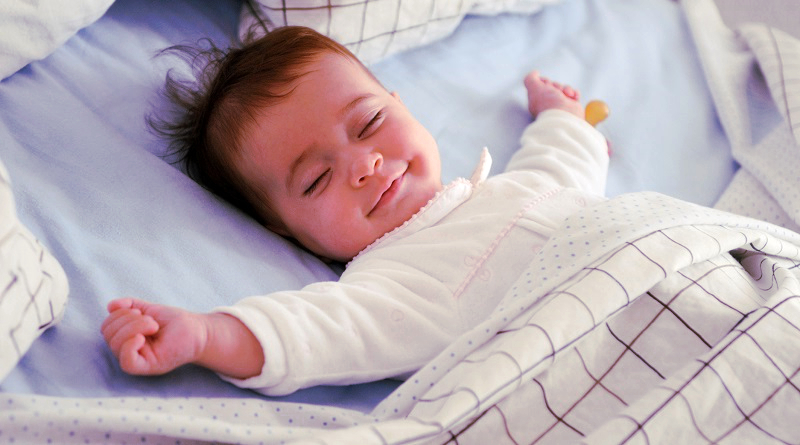Rock-A-Bye Baby! Sleep Safety.
January 8, 2021

What You Can Do: Recommendations for Infant Sleep Safety
Until their first birthday, babies should sleep on their backs for all sleep times—for naps and at night. We know babies who sleep on their backs are much less likely to die of SIDS than babies who sleep on their stomachs or sides. The problem with the side position is that the baby can roll more easily onto the stomach. Some parents worry that babies will choke when on their backs, but the baby’s airway anatomy and the gag reflex will help keep that from happening. Even babies with Gastroesophageal Reflux (GERD) should sleep on their backs.
- Newborns should be placed skin to skin with their mother as soon after birth as possible, at least for the first hour. After that, or when the mother needs to sleep or cannot do skin-to-skin, babies should be placed on their backs in the bassinet. While preemies may need to be on their stomachs temporarily while in the NICU due to breathing problems, they should be placed on their backs after the problems resolve, so that they can get used to being on their backs and before going home.
- Some babies will roll onto their stomachs. You should always place your baby to sleep on the back, but if your baby is comfortable rolling both ways (back to tummy, tummy to back), then you do not have to return your baby to the back. However, be sure that there are no blankets, pillows, stuffed toys, or bumper pads around your baby, so that your baby does not roll into any of those items, which could cause blockage of air flow.
- If your baby falls asleep in a car seat, stroller, swing, infant carrier, or sling, you should move him or her to a firm sleep surface on his or her back as soon as possible.
Use a firm sleep surface. A crib, bassinet, portable crib, or play yard that meets the safety standards of the Consumer Product Safety Commission is recommended along with a tight-fitting, firm mattress and fitted sheet designed for that particular product. Nothing else should be in the crib except for the baby. A firm surface is a hard surface; it should not indent when the baby is lying on it.
Room share—keep baby’s sleep area in the same room where you sleep for the first 6 months or, ideally, for the first year. Place your baby’s crib, bassinet, portable crib, or play yard in your bedroom, close to your bed. The AAP recommends room sharing because it can decrease the risk of SIDS by as much as 50% and is much safer than bed sharing. In addition, room sharing will make it easier for you to feed, comfort, and watch your baby.
Only bring your baby into your bed to feed or comfort. Place your baby back in his or her own sleep space when you are ready to go to sleep. If there is any possibility that you might fall asleep, make sure there are no pillows, sheets, blankets, or any other items that could cover your baby’s face, head, and neck, or overheat your baby. As soon as you wake up, be sure to move the baby to his or her own bed.
Never place your baby to sleep on a couch, sofa, or armchair. This is an extremely dangerous place for your baby to sleep.
Bed-sharing is not recommended for any babies. However, certain situations make bed-sharing even more dangerous. Therefore, you should not bed share with your baby if:
- Your baby is younger than 4 months old.
- Your baby was born prematurely or with low birth weight.
- You or any other person in the bed is a smoker (even if you do not smoke in bed).
- The mother of the baby smoked during pregnancy.
- You have taken any medicines or drugs that might make it harder for you to wake up.
- You drank any alcohol.
- You are not the baby’s parent.
- The surface is soft, such as a waterbed, old mattress, sofa, couch, or armchair.
- There is soft bedding like pillows or blankets on the bed.
Keep soft objects, loose bedding, or any objects that could increase the risk of entrapment, suffocation, or strangulation out of the baby’s sleep area. These include pillows, quilts, comforters, sheepskins, blankets, toys, bumper pads or similar products that attach to crib slats or sides. If you are worried about your baby getting cold, you can use infant sleep clothing, such as a wearable blanket. In general, your baby should be dressed with only one layer more than you are wearing.
It is fine to swaddle your baby. However, make sure that the baby is always on his or her back when swaddled. The swaddle should not be too tight or make it hard for the baby to breathe or move his or her hips. When your baby looks like he or she is trying to roll over, you should stop swaddling.
Try giving a pacifier at nap time and bedtime. This helps reduce the risk of SIDS, even if it falls out after the baby is asleep. If you are breastfeeding, wait until breastfeeding is going well before offering a pacifier. This usually takes 2-3 weeks. If you are not breastfeeding your baby, you can start the pacifier whenever you like. It is OK if your baby does not want a pacifier. You can try offering again later, but some babies simply do not like them. If the pacifier falls out after your baby falls asleep, you do not have to put it back in.
Next Post >>